Motorola Mobility P56MC1 Mobile Phone User Manual 3 of 3
Motorola Mobility LLC Mobile Phone 3 of 3
Contents
User Manual 3 of 3
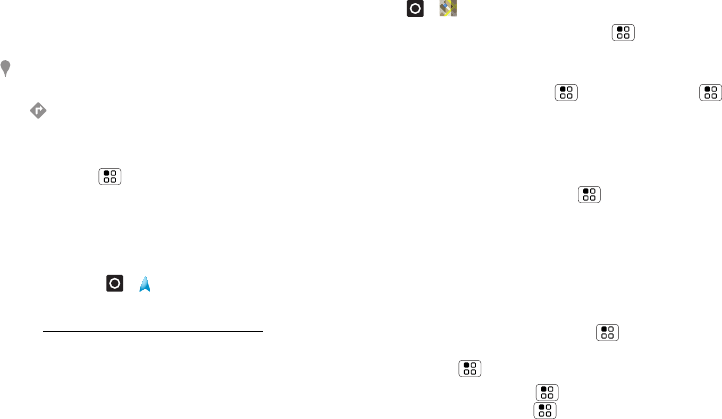
19Location
•To find an address, enter it in the search box at the top.
The map moves to show the address.
Tip: You can touch and hold a spot on the map to show
the nearest address.
•To find stores, restaurants, and other places near you,
touch at the top.
•To get directions, find an address on the map, touch it,
then touch .
•To save an address for later, touch it, then touch the star
by its name to add it to your Starred Places.
•For help, touch Menu > More > Help.
Google Maps™ Navigation
Google Maps Navigation is an Internet-connected GPS
navigation system with voice guidance.
To open navigation, touch > Navigation. Follow the
prompts to speak or type your destination.
For more, go to www.google.com/mobile/navigation.
Google Latitude™
Google Latitude lets you see where your friends and family
are on Google Maps™. Plan to meet up, check that they got
home safely, or just stay in touch. Don’t worry, your location
is not shared unless you agree to it. After you join Google
Latitude, you can invite your friends to view your location,
or accept their invitations.
Touch > Maps and then:
•To join Google Latitude, touch Menu > Join
Latitude. Read the privacy policy and, if you agree with
it, choose to continue.
•To add friends, touch Menu > Latitude > Menu
> Add friends.
Touch Select from Contacts or Add via email address,
then touch a contact and Add friends. Your friend will
receive an email notice.
•To remove friends, touch Menu > Latitude to show
your friends list. Touch a name, then touch Remove.
•To share your location when you receive a request, you
can choose Accept and share back (show your location
and see theirs), Accept, but hide my location (hide your
location, but see theirs), or Don’t accept (hide both
locations).
•To hide your location, touch Menu > Latitude to
show your friends list. Touch your contact name, then
touch Menu > Settings > Do not detect your location.
•To sign out, touch Menu > Latitude to show your
friends list. Touch Menu > Settings > Sign out of
Latitude.
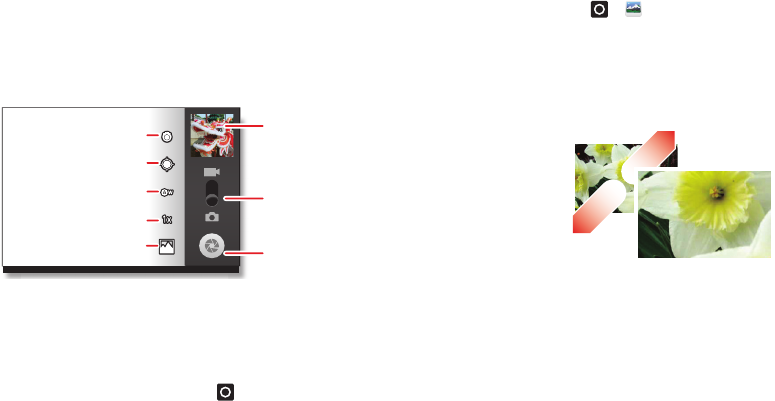
20 Photos & videos
Photos & videos
see it, capture it, share it!
Capture photos and videos to send them to friends or save
them for later.
Quick start: Photos & videos
From any screen, press the Camera Key on the right side of
the phone to open the camera.
•To take a photo, open the camera, then press the Camera
Key.
•To record a video, open the camera, then touch the
camcorder icon to switch to the camcorder. Press the
Camera Key to start and stop recording.
•To open photos and videos, touch > My Gallery, then
touch a photo or video for options like Share.
Open your last
photo or video.
Switch resolution & more.
Store photo location.
Set white balance for your
lighting.
Zoom.
Choose front or back
camera.
Choose camera
or camcorder.
Capture.
Tip: For the clearest photos and videos, clean the lens with a
soft, dry cloth.
View & share photos & videos
From the home screen, touch > My gallery.
Flick left and right to show folders. Touch a folder to show
its photos or videos, then touch a thumbnail image to open,
share, or delete it.
Tip: From the viewfinder, you can touch the thumbnail in
the top right to open your last photo or video.
•To zoom in, touch
the screen with two
fingers and then drag
them apart. To zoom
out, drag your fingers
together.
•To send or post the
photo or video,
touch Share.
To use a Bluetooth or cable connection, see “Bluetooth™,
Wi-Fi, & cable connections” on page 24.
•To delete the photo or video, touch Delete.
•To set a photo as your wallpaper or a contact photo,
touch More > Set as.
•To crop or rotate a photo, touch More.
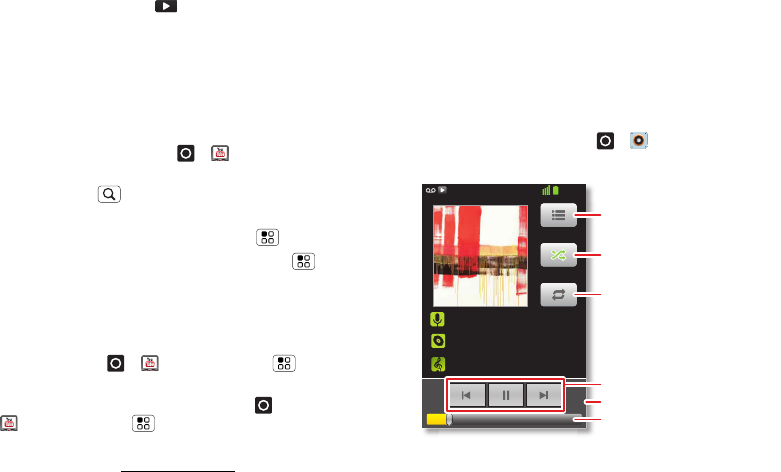
21Music
•To play a video, touch .
Tip: Turn the phone sideways for a widescreen view.
YouTube™
The YouTube user-generated content website lets you share
videos with YouTube users everywhere. You don’t need a
YouTube account to browse and view videos.
From the home screen, touch > YouTube.
•To watch videos, touch a category like Top rated or
touch Search to find a video. Touch a video to watch
it.
For more video categories, touch Menu > Categories.
To watch a video in high quality, touch Menu >
Settings > High quality video.
•To share a video, touch it to open it, touch More at the
top, choose Share, then choose how you want to share it.
•To upload a video from your phone to your YouTube
account, touch > YouTube > Menu > Upload.
Touch the video, then touch Upload.
To sign into your YouTube account, touch >
YouTube > Menu > My account.
Note: If you don’t have an account, touch the link to create
one. For more, visit www.youtube.com.
Music
when music is what you need...
Keep your music with you! Put music on your phone so you
can listen and create playlists anytime.
Quick start: Music
From the home screen, touch > Music, then choose a
song to play it:
•To adjust volume, use the volume keys.
Music Artist
Album Title
Song Title
0:26 3:27
11:19
Open Playlist
Shuffle On/Off
Repeat Off/All/Current
Music Controls
Total Song Time
Progress Bar
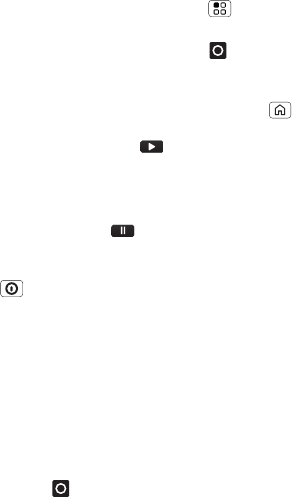
22 Music
•When a song is playing, you touch Menu to add it to
a playlist or use it as a ringtone.
To edit, delete, or rename playlists, touch > Music
touch the Playlists tab, then touch and hold the playlist
name.
•To hide the player and use other apps, touch Home .
Your music keeps playing. To return to the player, flick
down the status bar and touch .
Tip: For quick music player controls, touch and hold an
empty spot in your home screen, then choose Widget >
Music.
•To stop the player, touch .
•Before a flight, turn off network and wireless connections
so that you can keep listening to music: Press and hold
Power > Airplane mode.
Note: When you select airplane mode, all wireless
services are disabled. You can then turn Wi-Fi and/or
Bluetooth back on, if permitted by your airline. Other
wireless voice and data services (such as calls and text
messages) remain off in airplane mode. Emergency calls
to your region's emergency number can still be made.
You can use your phone’s 3.5mm OMTP headset jack to
connect wired headphones, or go wireless with .
To listen to FM radio stations, Plug in a 3.5mm OMTP
headset and touch > FM Radio. Your phone uses the
headset wire as the radio antenna.
Music files
To get songs for your music player, you can download them
from online services or copy them from your computer. Your
music player can play these file formats: MP3, M4A, AAC,
ACC+, MIDI, WAV, or OGG Vorbis.
Note: Your phone does not support any DRM protected
files.
Note: Copyright—do you have the right? Always follow the
rules. See “Content Copyright” in your legal and safety
information.
To copy files from your computer to your phone, you can
use “Cable connections” on page 26 or “Bluetooth™ devices”
on page 24.
To save a CD on your computer (“rip” the CD), you can use
a program like Microsoft™ Windows™ Media Player. First,
make sure you change the format to MP3 (under Rip >
Format in Windows Media Player).
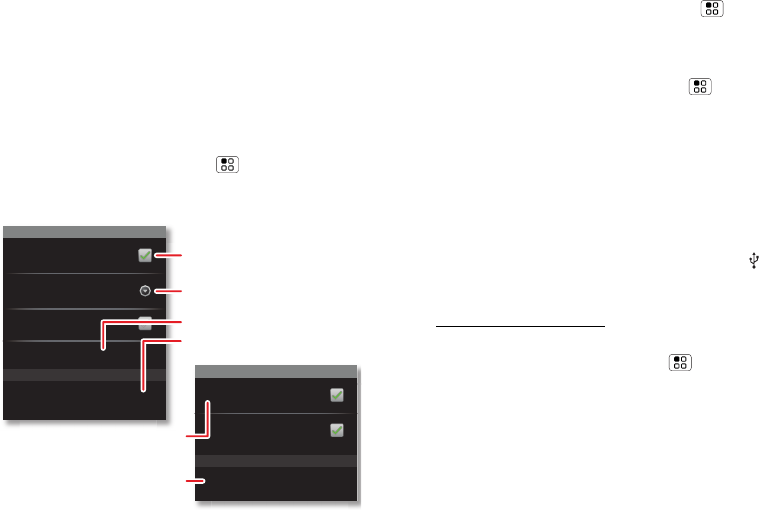
23Bluetooth™, Wi-Fi, & cable connections
Bluetooth™, Wi-Fi, & cable
connections
home, office, or hotspot
Connect your phone to Bluetooth headsets, fast Wi-Fi
networks, or right to your computer.
Quick start: connections
From the home screen, touch Menu > Settings >
Wireless & networks, then Bluetooth settings or Wi-Fi
settings.
Wi-Fi networks
Wi-Fi settings
Notify me when an open network is
available
Network notification
(Your network)
Wi-Fi
Bluetooth devices
Bluetooth settings
(Your Phone)
Device name
Scan for devices
Make device discoverable
Discoverable
Bluetooth
Pair with this device
(Nearby Bluetooth Device)
Turn Bluetooth power on & scan,
or turn off.
Change your phone’s Bluetooth
device name.
Turn Wi-Fi power on & scan, or
turn off.
Re-scan.
Connect a device found by the
scan.
Connect a network found by the
scan.
•To connect Bluetooth devices, touch Menu >
Settings > Wireless & networks > Bluetooth settings >
Scan for devices (or Bluetooth, if it is off). Touch a device
that your phone found, to connect it.
•To connect Wi-Fi networks, touch Menu > Settings
> Wireless & networks > Wi-Fi settings (then touch
Wi-Fi, if it is off). Touch a network that your phone
found, to connect it.
•To use a cable connection, connect your phone’s micro
USB port to a standard USB port on your computer, then
use a computer program to transfer files to and from your
phone’s memory card. Your phone supports microSD
cards up to 32GB.
On your phone, flick down the status bar and touch to
enable your phone’s memory card.
You can download your phone’s driver files from
www.motorola.com/support.
•To make your phone a hotspot that other devices can use
to connect to the Internet, touch Menu > Settings >
Wireless & networks > Tethering & portable hotspot.
Then, choose to enable USB tethering or Portable Wi-Fi
hotspot.
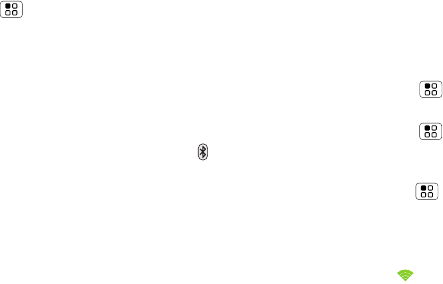
24 Bluetooth™, Wi-Fi, & cable connections
Bluetooth™ devices
Note: This requires an optional accessory.
You can connect your phone to other Bluetooth devices for
handsfree calls, file transfers, and more:
1Make sure the device you are pairing with is in
discoverable mode.
Note: For questions about a Bluetooth device, check the
manufacturer’s manual or website.
2Touch Menu > Settings > Wireless & networks >
Bluetooth settings.
3Touch Scan for devices (or touch Bluetooth if it is turned
off). Your phone scans, and lists nearby devices.
4Touch a device to connect.
5If necessary, touch Pair or enter the device passkey (like
0000) to connect to the device. When the device is
connected, the Bluetooth connected indicator appears
in the status bar.
To reconnect a device you’ve connected before, just turn
it on.
To disconnect a device, just turn it off.
Note: Using a mobile device or accessory while driving may
cause distraction and may be illegal. Always obey the laws
and drive safely.
Tip: Touch and hold an empty spot on your home screen,
then choose Widgets > Power Control for a widget that lets
you turn on or off Wi-Fi, Bluetooth, Use GPS satellites, and
more.
Note: Your phone's Bluetooth features and Bluetooth Class
1 power levels are not allowed for outdoor operation in
France. To avoid unlawful interference with radio signals,
do not use the Bluetooth features in France unless you are
indoors.
Wi-Fi networks
You can connect to Wi-Fi networks for even faster Internet
access and to download data:
1Touch Menu > Settings > Wireless & networks >
Wi-Fi settings.
2Touch Menu > Scan (or touch Wi-Fi, if it is off. Your
phone scans for nearby networks.
To see your phone’s MAC address or other details,
touch Menu > Advanced.
3Touch a network to connect.
4If necessary, enter details from from the network
administrator. When your phone is connected, the Wi-Fi
indicator appears in the status bar.
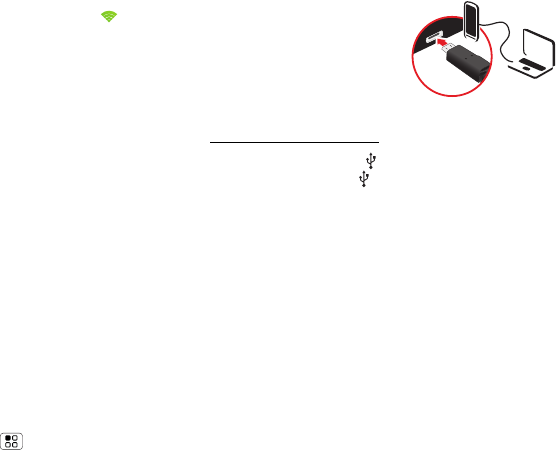
25Bluetooth™, Wi-Fi, & cable connections
When power is on and your phone finds a network
you’ve used, it automatically reconnects and shows in
the status bar.
Tip: Touch and hold an empty spot on your home screen,
then choose Widgets > Power Control for a widget that lets
you turn on or off Wi-Fi, Bluetooth, Use GPS satellites, and
more.
Note: Your phone's features and power levels are not
allowed for outdoor operation in France. To avoid unlawful
interference with radio signals, do not use the features in
France unless you are indoors.
Cable connections
You can use a cable connection to transfer songs, pictures, or
other files between your phone and computer. You will need
a:
•Microsoft™ Windows™ PC or Apple™ Macintosh™.
•Data cable with a standard USB connector on one end and
a micro USB connector on the other end.
•microSD memory card (up to 32GB) inserted in your
phone, as shown in “Assemble & charge” on page 3.
Tip: To see the available memory on your memory card,
from the home screen touch Menu > Settings >
Storage.
To connect your phone and computer with a cable:
1Insert a memory card in your
phone, then connect your
phone’s micro USB port to a
USB port on your computer.
Note: If your computer asks
for your phone’s driver files,
you can download them from
www.motorola.com/support.
2Your phone should show in the status bar. Flick down
the status bar, touch the to enable your phone’s
memory card.
3On your computer, open a program (like Windows™
Media Player for music files, or Microsoft™ Windows™
Explorer to drag and drop other files) and use it to
transfer your files.
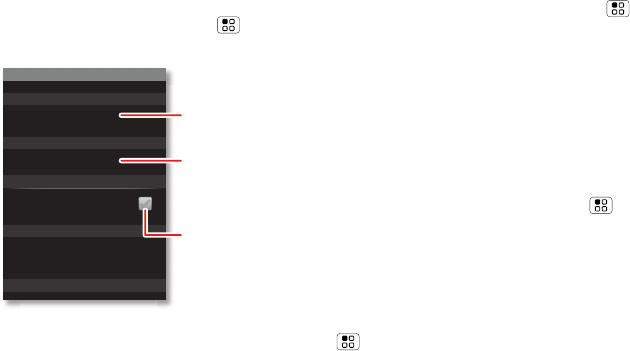
26 Security
Security
help keep your phone safe
Protect your information, in case your phone is lost or
stolen.
Quick start: Security
From the home screen, touch Menu > Settings >
Location & security.
•To set a lock pattern, PIN, or password that you must
enter whenever you wake up the screen, touch Menu
> Settings > Location & security > Set up screen lock.
Device administration
Lock screen with a pattern, PIN, or password
Set up screen lock
Show password as you type
Turn off ephemeris auto download
Visible passwords
Credential storage
Screen unlock
Passwords
Add or remove device administrators
Select device administrators
Location & security settings
Set up SIM card lock
SIM card lock
Show password letters and
numbers when you enter them
(rather than ***).
Choose a number code required
to turn on your phone.
Set a lock pattern, PIN, or
password required to wake up
the screen.
Follow the prompts to enter and confirm the pattern, PIN,
or password.
Note: You can make emergency calls on a locked phone
(“Contacts” on page 12). A locked phone still rings, but
you need to unlock it to answer.
•To set a SIM card PIN that you must enter when you turn
on your phone, touch Menu > Settings > Location &
security > Set up SIM card lock > Lock SIM card. Enter
your SIM PIN code. To change your code, choose Change
SIM PIN.
Caution: If you enter an incorrect PIN code three times,
your phone locks your SIM card. To unlock it, you need a
PUK code from your service provider.
Reset
To reset your phone to factory settings and erase all the data
on your phone, touch Menu > Settings > Privacy >
Factory data reset > Reset phone.
Warning: All downloaded apps and user data on your phone
will be deleted.

27Tips & tricks
Tips & tricks
a few handy hints
Make it faster and easier to get the most out of your phone
every day.
General tips
•Touch Search in the home screen to search across
your apps, contacts, web, and maps—or just enter the
address for a place or a web page. Touch Search in
Market, Messaging, Music, and other apps to search
within the app.
•Use folders to organize shortcuts and contacts on your
home screen.
Touch and hold a blank spot on your home screen, then
touch Folders. To move shortcuts into a New folder, touch
and hold a shortcut, then drag it to the folder icon.
•Touch and hold Home to show your most recent
apps.
•Touch and hold the status bar at the top of your phone to
show the date.
•To change which location information your phone uses,
touch Menu > Settings > Location & security.
•To back up your app data, passwords, and other settings
to Google servers, touch Menu > Settings > Privacy >
Back up my data.
Battery tips
Your phone is like a small computer, giving you a lot of
information and apps, at 3G speed, with a touch display!
Depending on what you use, that can take a lot of power. So,
if you want to save battery life between charges, you could
reduce:
•recording or watching videos, listening to music, or
taking pictures.
•widgets that stream information to your home screen, like
news or weather.
•Bluetooth™ use: touch Menu > Settings > Wireless
& networks > Bluetooth (turn off).
• use: touch Menu > Settings > Wireless & networks >
Wi-Fi (turn off).
•GPS use: touch Menu > Settings > Location &
security > Use GPS satellites (deselect).
•network searching: if you are out of coverage, to keep
your phone from looking for networks, press and hold
Power > Airplane mode.
•display brightness: touch Menu > Settings > Display
> Brightness > (dimmer setting).
•display timeout delay: touch Menu > Settings >
Display > Screen timeout > (shorter setting).
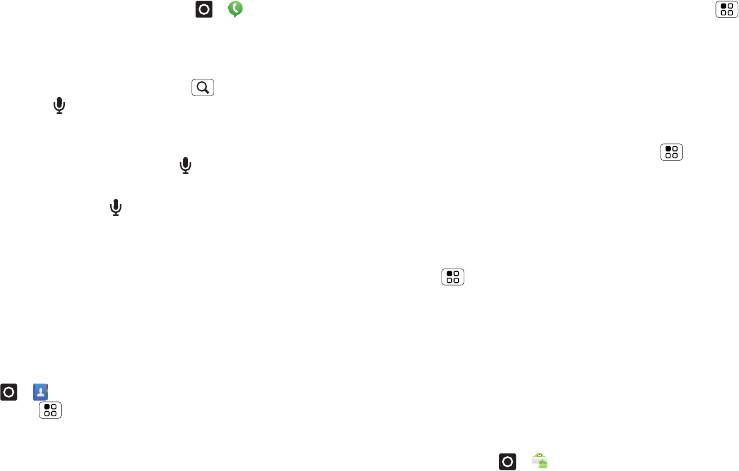
28 Tips & tricks
Voice recognition
• Dialing and commands: Touch > Voice Dialer. To
dial, say “Call” and then a contact name or phone number.
You can also say a command from the list shown, like
“Open Calendar.”
•Search: Touch and hold Search to open voice search,
or touch on a search box, then say what you want to
search for, like “Motorola accessories”.
• Text entry: Touch a text entry field to open the
touchscreen keyboard. Touch , then say what you want
to type.
Note: There is no on the Swype keyboard. To change
the keyboard, touch and hold a blank spot in the text box.
A menu opens, where you can choose Input Method >
Multi-touch keyboard.
Tip: Speak naturally but clearly, like using a speakerphone.
Caller ID
When you want to hear who’s calling:
• Ringtones: Assign a unique ringtone to a contact— touch
> Contacts, touch the contact, then touch
Menu > Options.
Volume & vibrate
To set your ringer volume or vibration, touch Menu >
Settings > Sound > Vibrate or Volume.
Tip: To set separate volumes for calls and notifications (like
new messages), choose Volume and uncheck Use incoming
call volume for notifications.
Display brightness
To change display brightness, touch Menu > Settings >
Display > Brightness
Uncheck Automatic brightness to set your own level.
Touchscreen & keys
You can hear or feel when you touch the touchscreen: Touch
Menu > Settings > Sound:
•Touchscreen: To hear screen touches (click), select
Audible selection.
•Keys: To feel screen keyboard touches (vibrate), select
Haptic feedback.
Apps
Want more? No problem. Android Market™ provides access
to thousands of apps, and many provide useful accessibility
features: Touch > Market.

29Troubleshooting
Troubleshooting
we’re here to help
Crash recovery
In the unlikely event that your phone stops responding to
touchs and key presses, try a quick reset. Remove the back
cover and battery (“Assemble & charge” on page 3), then
replace and turn on your phone as usual.
Service & repairs
If you have questions or need assistance, we're here to help.
Go to www.motorola.com/support, where you can select
from a number of customer care options. You can also
contact the Motorola Customer Support Center at
1-800-331-6456 (United States), 1-888-390-6456
(TTY/TDD United States for hearing impaired), or
1-800-461-4575 (Canada).

30 Troubleshooting
Safety, Regulatory & Legal
Battery Use & Safety
Battery Use & Safety
Important: Handle and store batteries properly to avoid
injury or damage. Most battery issues arise from improper
handling of batteries, and particularly from the continued use of
damaged batteries.
DON’Ts
• Don’t disassemble, crush, puncture, shred, or otherwise
attempt to change the form of your battery.
• Don’t let the mobile device or battery come in contact with
liquids.* Liquids can get into the mobile device’s circuits,
leading to corrosion.
• Don’t allow the battery to touch metal objects. If metal
objects, such as jewelry, stay in prolonged contact with the
battery contact points, the battery could become very hot.
• Don’t place your mobile device or battery near a heat
source.* High temperatures can cause the battery to swell,
leak, or malfunction.
• Don’t dry a wet or damp battery with an appliance or heat
source, such as a hair dryer or microwave oven.
DOs
• Do avoid leaving your mobile device in your car in high
temperatures.*
• Do avoid dropping the mobile device or battery.*
Dropping these items, especially on a hard surface, can
potentially cause damage.*
• Do contact your service provider or Motorola if your
mobile device or battery has been damaged by dropping,
liquids or high temperatures.
*Note: Always make sure that the battery compartment and any
connector covers are closed and secure to avoid direct exposure
of the battery to any of these conditions, even if your product
information states that your mobile device can resist damage
from these conditions.
Important: Motorola recommends you always use
Motorola-branded batteries and chargers for quality
assurance and safeguards. Motorola’s warranty does not cover
damage to the mobile device caused by non-Motorola batteries
and/or chargers. To help you identify authentic Motorola
batteries from non-original or counterfeit batteries (that may not
have adequate safety protection), Motorola provides holograms
on its batteries. You should confirm that any battery you
purchase has a “Motorola Original” hologram.
If you see a message on your display such as Invalid Battery or
Unable to Charge, take the following steps:
• Remove the battery and inspect it to confirm that it has a
“Motorola Original” hologram;
• If there is no hologram, the battery is not a Motorola
battery;
• If there is a hologram, replace the battery and try charging
it again;
• If the message remains, contact a Motorola authorized
service center.
Warning: Use of a non-Motorola battery or charger may present
a risk of fire, explosion, leakage, or other hazard.
Proper and safe battery disposal and recycling: Proper battery
disposal is not only important for safety, it benefits the
environment. You can recycle your used batteries in many retail
or service provider locations. Additional information on proper
disposal and recycling can be found at
www.motorola.com/recycling

31
Disposal: Promptly dispose of used batteries in
accordance with local regulations. Contact your local
recycling center or national recycling organizations for
more information on how to dispose of batteries.
Warning: Never dispose of batteries in a fire because they may
explode.
Battery Charging
Battery Charging
Notes for charging your product’s battery:
• During charging, keep your battery and charger near
room temperature for efficient battery charging.
• New batteries are not fully charged.
• New batteries or batteries stored for a long time may take
more time to charge.
• Motorola batteries and charging systems have circuitry
that protects the battery from damage from overcharging.
Third Party Accessories
Use of third party accessories, including but not limited to
batteries, chargers, headsets, covers, cases, screen protectors and
memory cards, may impact your mobile device’s performance.
In some circumstances, third party accessories can be dangerous
and may void your mobile device’s warranty. For a list of
Motorola accessories, visit www.motorola.com/products
Driving Precautions
Responsible and safe driving is your primary responsibility when
behind the wheel of a vehicle. Using a mobile device or
accessory for a call or other application while driving may cause
distraction. Using a mobile device or accessory may be
prohibited or restricted in certain areas, always obey the laws and
regulations on the use of these products.
032375o
While driving, NEVER:
• Type or read texts.
• Enter or review written data.
• Surf the web.
• Input navigation information.
• Perform any other functions that divert your attention
from driving.
While driving, ALWAYS:
• Keep your eyes on the road.
• Use a handsfree device if available or required by law in
your area.
• Enter destination information into a navigation device
before driving.
• Use voice activated features (such as voice dial) and
speaking features (such as audible directions), if available.
• Obey all local laws and regulations for the use of mobile
devices and accessories in the vehicle.
• End your call or other task if you cannot concentrate on
driving.
Remember to follow the “Smart Practices While Driving” in this
guide and at www.motorola.com/callsmart (in English only).
Seizures/Blackouts
Some people may be susceptible to epileptic seizures or
blackouts when exposed to flashing lights, such as when playing
videos or games. These may occur even if a person has never had
a previous seizure or blackout.
If you have experienced seizures or blackouts, or if you have a
family history of such occurrences, please consult with your
physician before playing videos or games or enabling a
flashing-lights feature (if available) on your mobile device.

32
Discontinue use and consult a physician if any of the following
symptoms occur: convulsion, eye or muscle twitching, loss of
awareness, involuntary movements, or disorientation. It is
always a good idea to hold the screen away from your eyes, leave
the lights on in the room, take a 15-minute break every hour, and
stop use if you are tired.
Caution About High Volume Usage
Warning: Exposure to loud noise from any source for
extended periods of time may affect your hearing.
The louder the volume sound level, the less time is
required before your hearing could be affected. To
protect your hearing:
• Limit the amount of time you use headsets or headphones
at high volume.
• Avoid turning up the volume to block out noisy
surroundings.
• Turn the volume down if you can’t hear people speaking
near you.
If you experience hearing discomfort, including the sensation of
pressure or fullness in your ears, ringing in your ears, or muffled
speech, you should stop listening to the device through your
headset or headphones and have your hearing checked.
For more information about hearing, see our website at
direct.motorola.com/hellomoto/nss/AcousticSafety.asp (in
English only).
Repetitive Motion
When you repetitively perform actions such as pressing keys or
entering finger-written characters, you may experience
occasional discomfort in your hands, arms, shoulders, neck, or
other parts of your body. If you continue to have discomfort
during or after such use, stop use and see a physician.
Children
Keep your mobile device and its accessories away from small
children. These products are not toys and may be hazardous to
small children. For example:
• A choking hazard may exist for small, detachable parts.
• Improper use could result in loud sounds, possibly causing
hearing injury.
• Improperly handled batteries could overheat and cause a
burn.
Similar to a computer, if a child does use your mobile device,
you may want to monitor their access to help prevent exposure to
inappropriate apps or content.
Glass Parts
Some parts of your mobile device may be made of glass. This
glass could break if the product receives a substantial impact. If
glass breaks, do not touch or attempt to remove. Stop using your
mobile device until the glass is replaced by a qualified service
center.
Operational Warnings
Obey all posted signs when using mobile devices in public areas.
Potentially Explosive Atmospheres
Areas with potentially explosive atmospheres are often, but not
always, posted and can include fueling areas, such as below
decks on boats, fuel or chemical transfer or storage facilities, or
areas where the air contains chemicals or particles, such as grain
dust, or metal powders.
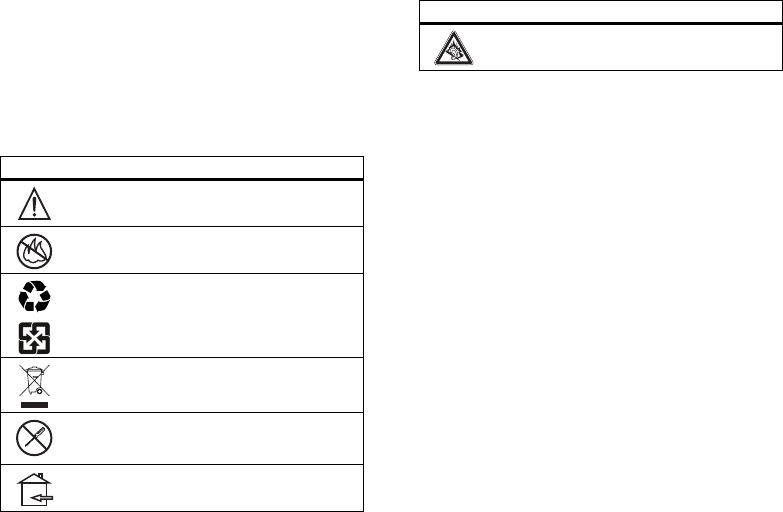
33
When you are in such an area, turn off your mobile device, and
do not remove, install, or charge batteries unless it is a radio
product type especially qualified for use in such areas as
“Intrinsically Safe” (for example, Factory Mutual, CSA, or UL
approved). In such areas, sparks can occur and cause an
explosion or fire.
Symbol Key
Your battery, charger, or mobile device may contain symbols,
defined as follows:
Symbol Definition
Important safety information follows.
Do not dispose of your battery or mobile device
in a fire.
Your battery or mobile device may require
recycling in accordance with local laws. Contact
your local regulatory authorities for more
information.
Do not dispose of your battery or mobile device
with your household waste. See “Recycling” for
more information.
Do not use tools.
For indoor use only.
032374o
032376o
032375o
Radio Frequency (RF) Energy
Exposure to RF Energy
Your mobile device contains a transmitter and receiver. When it
is ON, it receives and transmits RF energy. When you
communicate with your mobile device, the system handling your
call controls the power level at which your mobile device
transmits.
Your mobile device is designed to comply with local regulatory
requirements in your country concerning exposure of human
beings to RF energy.
RF Energy Operational Precautions
For optimal mobile device performance, and to be sure that
human exposure to RF energy does not exceed the guidelines set
forth in the relevant standards, always follow these instructions
and precautions:
• When placing or receiving a phone call, hold your mobile
device just like you would a landline phone.
• If you wear the mobile device on your body, always place
the mobile device in a Motorola-supplied or approved clip,
holder, holster, case, or body harness. If you do not use a
body-worn accessory supplied or approved by Motorola,
keep the mobile device and its antenna at least 2.5 cm
(1 inch) from your body when transmitting.
• Using accessories not supplied or approved by Motorola
may cause your mobile device to exceed RF energy
Listening at full volume to music or voice
through a headset may damage your hearing.
Symbol Definition

34
exposure guidelines. For a list of Motorola-supplied or
approved accessories, visit our website at:
www.motorola.com.
RF Energy Interference/Compatibility
Nearly every electronic device is subject to RF energy
interference from external sources if inadequately shielded,
designed, or otherwise configured for RF energy compatibility.
In some circumstances, your mobile device may cause
interference with other devices.
Follow Instructions to Avoid Interference Problems
Turn off your mobile device in any location where posted notices
instruct you to do so.
In an aircraft, turn off your mobile device whenever instructed to
do so by airline staff. If your mobile device offers an airplane
mode or similar feature, consult airline staff about using it in
flight.
Implantable Medical Devices
If you have an implantable medical device, such as a pacemaker
or defibrillator, consult your physician before using this mobile
device.
Persons with implantable medical devices should observe the
following precautions:
• ALWAYS keep the mobile device more than 20 centimeters
(8 inches) from the implantable medical device when the
mobile device is turned ON.
• DO NOT carry the mobile device in the breast pocket.
• Use the ear opposite the implantable medical device to
minimize the potential for interference.
• Turn OFF the mobile device immediately if you have any
reason to suspect that interference is taking place.
Read and follow the directions from the manufacturer of your
implantable medical device. If you have any questions about
using your mobile device with your implantable medical device,
consult your healthcare provider.
SAR (ICNIRP)
Your mobile device is a radio transmitter and receiver. It is
designed not to exceed the limits for exposure to radio waves
The radio wave exposure guidelines use a unit of measurement
known as the Specific Absorption Rate, or SAR. The SAR limit
Tests for SAR are conducted using standard operating positions
with the device transmitting at its highest certified power level in
all tested frequency bands. The highest SAR values under the
During use, the actual SAR values for your device are usually
well below the values stated. This is because, for purposes of
system efficiency and to minimize interference on the network,
Specific Absorption Rate (IEEE)
YOUR MOBILE DEVICE MEETS FCC LIMITS FOR
EXPOSURE TO RADIO WAVES.
(radio frequency electromagnetic fields) adopted by the
Federal Communications Commission (FCC).
These limits
include a substantial safety margin designed to assure the
safety of all persons, regardless of age and health.
for mobile devices is 1.6W/kg.
FCC guidelines for your device model are listed below:
0.679W/kg
Head SAR GSM 850/1900/WCDMA 850
Body-worn GSM 850/1900/WCDMA 850
Wi-Fi, Bluetooth
SAR Wi-Fi, Bluetooth
1.03W/kg
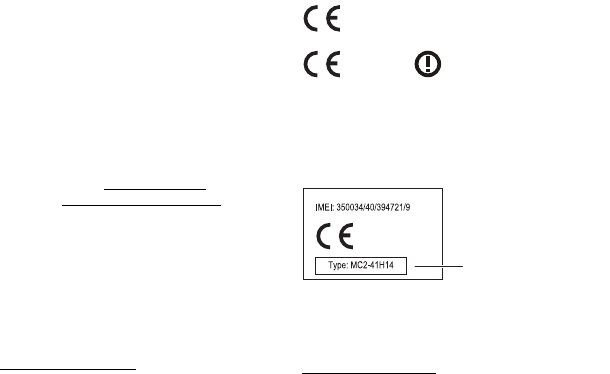
35
the operating power of your mobile device is automatically
decreased when full power is not needed for the call. The lower
the power output of the device, the lower its SAR value.
Body-worn SAR testing has been carried out using an approved
RF exposure guidelines during body-worn operation, the device
accessory, ensure that whatever product is used is free of any
away from the body.
The World Health Organization has stated that present scientific
information does not indicate the need for any special
precautions for the use of mobile devices. They recommend that
if you are interested in further reducing your exposure then you
can easily do so by limiting your usage or simply using a
hands-free kit to keep the device away from the head and body.
Additional information can be found at www.who.int/emf
(World Health Organization) or www.motorola.com/rfhealth
(Motorola Mobility, Inc.).
Information from the World Health
Organization
WHO Information
“A large number of studies have been performed over the last
two decades to assess whether mobile phones pose a potential
health risk. To date, no adverse health effects have been
established for mobile phone use.”
Source: WHO Fact Sheet 193
Further information: http://www.who.int/emf
European Union Directives
Conformance Statement
EU Conformance
The following CE compliance information is applicable to
Motorola mobile devices that carry one of the following CE
marks:
Hereby, Motorola declares that this product is in compliance
with:
• The essential requirements and other relevant provisions
of Directive 1999/5/EC
• All other relevant EU Directives
The above gives an example of a typical Product Approval
Number.
You can view your product’s Declaration of Conformity (DoC)
to Directive 1999/5/EC (to R&TTE Directive) at
www.motorola.com/rtte. To find your DoC, enter the Product
Approval Number from your product’s label in the “Search” bar
on the website.
0168
[Only Indoor Use Allowed In France
for Bluetooth and/or Wi-Fi]
0168
0168
Product
Approval
Number
accessory or at a separation distance of 1cm . To meet
should be in an approved accessory or positioned at least 1cm
away from the body. If you are not using an approved
metal and that it positions the phone at least 1cm

36
FCC Notice to Users
FCC Notice
The following statement applies to all products that bear the
FCC logo on the product label.
This equipment has been tested and found to comply with the
limits for a Class B digital device, pursuant to part 15 of the FCC
Rules. See 47 CFR Sec. 15.105(b). These limits are designed to
provide reasonable protection against harmful interference in a
residential installation. This equipment generates, uses and can
radiate radio frequency energy and, if not installed and used in
accordance with the instructions, may cause harmful interference
to radio communications. However, there is no guarantee that
interference will not occur in a particular installation. If this
equipment does cause harmful interference to radio or television
reception, which can be determined by turning the equipment off
and on, the user is encouraged to try to correct the interference
by one or more of the following measures:
• Reorient or relocate the receiving antenna.
• Increase the separation between the equipment and the
receiver.
• Connect the equipment to an outlet on a circuit different
from that to which the receiver is connected.
• Consult the dealer or an experienced radio/TV technician
for help.
This device complies with part 15 of the FCC Rules. Operation is
subject to the following two conditions: (1) This device may not
cause harmful interference, and (2) this device must accept any
interference received, including interference that may cause
undesired operation. See 47 CFR Sec. 15.19(a)(3).
Motorola has not approved any changes or modifications to this
device by the user. Any changes or modifications could void the
user’s authority to operate the equipment. See 47 CFR Sec.
15.21.
For products that support W-Fi 802.11a (as defined in the
product specifications available at www.motorola.com), the
following information applies. This equipment has the capability
to operate Wi-Fi in the 5 GHz Unlicensed National Information
Infrastructure (U-NII) band. Because this band is shared with
MSS (Mobile Satellite Service), the FCC has restricted such
devices to indoor use only (see 47 CFR 15.407(e)). Since
wireless hot spots operating in this band have the same
restriction, outdoor services are not offered. Nevertheless, please
do not operate this device in Wi-Fi mode when outdoors.
Location Services (GPS & AGPS)
GPS & AGPS
The following information is applicable to Motorola mobile
devices that provide location based (GPS and/or AGPS)
functionality.
Your mobile device can use Global Positioning System (GPS)
signals for location-based applications. GPS uses satellites
controlled by the U.S. government that are subject to changes
implemented in accordance with the Department of Defense
policy and the Federal Radio Navigation Plan. These changes
may affect the performance of location technology on your
mobile device.
Your mobile device can also use Assisted Global Positioning
System (AGPS), which obtains information from the cellular
network to improve GPS performance. AGPS uses your wireless
service provider's network and therefore airtime, data charges,
and/or additional charges may apply in accordance with your
service plan. Contact your wireless service provider for details.

37
Your Location
Location-based information includes information that can be
used to determine the approximate location of a mobile device.
Mobile devices which are connected to a wireless network
transmit location-based information. Devices enabled with GPS
or AGPS technology also transmit location-based information.
Additionally, if you use applications that require location-based
information (e.g. driving directions), such applications transmit
location-based information. This location-based information
may be shared with third parties, including your wireless service
provider, applications providers, Motorola, and other third
parties providing services.
Emergency Calls
When you make an emergency call, the cellular network may
activate the AGPS technology in your mobile device to tell the
emergency responders your approximate location.
AGPS has limitations and might not work in your area.
Therefore:
• Always tell the emergency responder your location to the
best of your ability; and
• Remain on the phone for as long as the emergency
responder instructs you.
Navigation
Navigation
The following information is applicable to Motorola mobile
devices that provide navigation features.
When using navigation features, note that mapping information,
directions and other navigational data may contain inaccurate or
incomplete data. In some countries, complete information may
not be available. Therefore, you should visually confirm that the
navigational instructions are consistent with what you see. All
drivers should pay attention to road conditions, closures, traffic,
and all other factors that may impact driving. Always obey
posted road signs.
Smart Practices While Driving
Driving Safety
Check the laws and regulations on the use of mobile devices
and their accessories in the areas where you drive. Always
obey them. The use of these devices may be prohibited or
restricted in certain areas—for example, handsfree use only
may be required. Go to www.motorola.com/callsmart
(in English only) for more information.
Your mobile device lets you communicate by voice and
data—almost anywhere, anytime, wherever wireless service is
available and safe conditions allow. When driving a car, driving
is your first responsibility. If you choose to use your mobile
device while driving, remember the following tips:
• Get to know your Motorola mobile device and its features
such as speed dial, redial and voice dial. If available, these
features help you to place your call without taking your
attention off the road.
• When available, use a handsfree device. If possible, add an
additional layer of convenience to your mobile device with
one of the many Motorola Original handsfree accessories
available today.
• Position your mobile device within easy reach. Be able to
access your mobile device without removing your eyes
from the road. If you receive an incoming call at an
inconvenient time, if possible, let your voicemail answer it
for you.
• Let the person you are speaking with know you are
driving; if necessary, suspend the call in heavy traffic or

38
hazardous weather conditions. Rain, sleet, snow, ice, and
even heavy traffic can be hazardous.
• Do not take notes or look up phone numbers while driving.
Jotting down a “to do” list or going through your address
book takes attention away from your primary
responsibility—driving safely.
• Dial sensibly and assess the traffic; if possible, place calls
when your car is not moving or before pulling into traffic.
If you must make a call while moving, dial only a few
numbers, check the road and your mirrors, then continue.
• Do not engage in stressful or emotional conversations that
may be distracting. Make people you are talking with
aware you are driving and suspend conversations that can
divert your attention away from the road.
• Use your mobile device to call for help. Dial 911 or other
local emergency number in the case of fire, traffic
accident, or medical emergencies (wherever wireless
phone service is available).
• Use your mobile device to help others in emergencies. If
you see an auto accident, crime in progress, or other
serious emergency where lives are in danger, call 911 or
other local emergency number (wherever wireless phone
service is available), as you would want others to do for
you.
• Call roadside assistance or a special non-emergency
wireless assistance number when necessary. If you see a
broken-down vehicle posing no serious hazard, a broken
traffic signal, a minor traffic accident where no one
appears injured, or a vehicle you know to be stolen, call
roadside assistance or other special non-emergency
wireless number (wherever wireless phone service is
available).
Privacy & Data Security
Privacy & Data Security
Motorola understands that privacy and data security are
important to everyone. Because some features of your mobile
device may affect your privacy or data security, please follow
these recommendations to enhance protection of your
information:
• Monitor access—Keep your mobile device with you and do
not leave it where others may have unmonitored access.
Use your device’s security and lock features, where
available.
• Keep software up to date—If Motorola or a
software/application vendor releases a patch or software
fix for your mobile device that updates the device’s
security, install it as soon as possible.
• Secure Personal Information—Your mobile device can
store personal information in various locations including
your SIM card, memory card, and phone memory. Be sure
to remove or clear all personal information before you
recycle, return, or give away your device. You can also
backup your personal data to transfer to a new device.
Note: For information on how to backup or wipe data from
your mobile device, go to www.motorola.com/support
• Online accounts—Some mobile devices provide a
Motorola online account (such as MOTOBLUR). Go to
your account for information on how to manage the
account, and how to use security features such as remote
wipe and device location (where available).
• Applications and updates—Choose your apps and updates
carefully, and install from trusted sources only. Some apps
can impact your phone’s performance and/or have access
to private information including account details, call data,
location details and network resources.
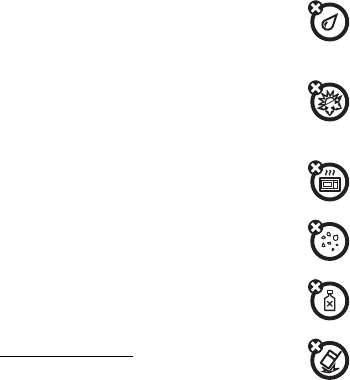
39
• Wireless—For mobile devices with Wi-Fi features, only
connect to trusted Wi-Fi networks. Also, when using your
device as a hotspot (where available) use network security.
These precautions will help prevent unauthorized access to
your device.
• Location-based information—Location-based information
includes information that can be used to determine the
approximate location of a mobile device. Mobile phones
which are connected to a wireless network transmit
location-based information. Devices enabled with GPS or
AGPS technology also transmit location-based
information. Additionally, if you use applications that
require location-based information (e.g. driving
directions), such applications transmit location-based
information. This location-based information may be
shared with third parties, including your wireless service
provider, applications providers, Motorola, and other
third parties providing services.
• Other information your device may transmit—Your
device may also transmit testing and other diagnostic
(including location-based) information, and other
non-personal information to Motorola or other third-party
servers. This information is used to help improve products
and services offered by Motorola.
If you have further questions regarding how the use of your
mobile device may impact your privacy or data security, please
contact Motorola at privacy@motorola.com, or contact your
service provider.
Use & Care
Use & Care
To care for your Motorola mobile device, please observe the
following:
liquids
Don’t expose your mobile device to water, rain,
extreme humidity, sweat, or other liquids. If it does get
wet, don’t try to accelerate drying with the use of an
oven or dryer, as this may damage the mobile device.
extreme heat or cold
Don’t store or use your mobile device in temperatures
below -10°C (14°F) or above 60°C (140°F). Don’t
recharge your mobile device in temperatures below
0°C (32°F) or above 45°C (113°F).
microwaves
Don’t try to dry your mobile device in a microwave
oven.
dust and dirt
Don’t expose your mobile device to dust, dirt, sand,
food, or other inappropriate materials.
cleaning solutions
To clean your mobile device, use only a dry soft cloth.
Don’t use alcohol or other cleaning solutions.
shock and vibration
Don’t drop your mobile device.

40
protection
To help protect your mobile device, always make sure
that the battery compartment and any connector covers
are closed and secure.
Recycling
Recycling
Mobile Devices & Accessories
Please do not dispose of mobile devices or electrical
accessories (such as chargers, headsets, or batteries)
with your household waste, or in a fire. These items
should be disposed of in accordance with the national
collection and recycling schemes operated by your local or
regional authority. Alternatively, you may return unwanted
mobile devices and electrical accessories to any Motorola
Approved Service Center in your region. Details of Motorola
approved national recycling schemes, and further information on
Motorola recycling activities can be found at:
www.motorola.com/recycling
Packaging & Product Guides
Product packaging and product guides should only be disposed
of in accordance with national collection and recycling
requirements. Please contact your regional authorities for more
details.
Software Copyright Notice
Software Copyright Notice
Motorola products may include copyrighted Motorola and
third-party software stored in semiconductor memories or other
media. Laws in the United States and other countries preserve for
Motorola and third-party software providers certain exclusive
rights for copyrighted software, such as the exclusive rights to
distribute or reproduce the copyrighted software. Accordingly,
any copyrighted software contained in Motorola products may
not be modified, reverse-engineered, distributed, or reproduced
in any manner to the extent allowed by law. Furthermore, the
purchase of Motorola products shall not be deemed to grant
either directly or by implication, estoppel, or otherwise, any
license under the copyrights, patents, or patent applications of
Motorola or any third-party software provider, except for the
normal, non-exclusive, royalty-free license to use that arises by
operation of law in the sale of a product.
Content Copyright
Content Copyright
The unauthorized copying of copyrighted materials is contrary to
the provisions of the Copyright Laws of the United States and
other countries. This device is intended solely for copying
non-copyrighted materials, materials in which you own the
copyright, or materials which you are authorized or legally
permitted to copy. If you are uncertain about your right to copy
any material, please contact your legal advisor.

41Troubleshooting
Open Source Software Information
OSS Information
For instructions on how to obtain a copy of any source code
being made publicly available by Motorola related to software
used in this Motorola mobile device, you may send your request
in writing to the address below. Please make sure that the request
includes the model number and the software version number.
MOTOROLA MOBILITY, INC.
OSS Management
600 North US Hwy 45
Libertyville, IL 60048
USA
The Motorola website opensource.motorola.com also contains
information regarding Motorola's use of open source.
Motorola has created the opensource.motorola.com website to
serve as a portal for interaction with the software
community-at-large.
To view additional information regarding licenses,
acknowledgments and required copyright notices for open source
packages used in this Motorola mobile device, please
press Menu Key > Settings > About phone > Legal
information > Open source licenses. In addition, this Motorola
device may include self-contained applications that present
supplemental notices for open source packages used in those
applications.
Copyright & Trademarks
Certain features, services and applications are network
dependent and may not be available in all areas; additional terms,
conditions and/or charges may apply. Contact your service
provider for details.
All features, functionality, and other product specifications, as
well as the information contained in this guide, are based upon
the latest available information and believed to be accurate at the
time of printing. Motorola reserves the right to change or modify
any information or specifications without notice or obligation.
Note: The images in this guide are examples only.
MOTOROLA and the Stylized M Logo are trademarks or
registered trademarks of Motorola Trademark Holdings, LLC.
Google, the Google logo, Google Maps, Google Talk, Google
Latitude, Gmail, YouTube, Picasa, Android and Android Market
are trademarks of Google, Inc. All other product or service
names are the property of their respective owners.
© 2011 Motorola Mobility, Inc. All rights reserved.
Caution: Motorola does not take responsibility for
changes/modification to the transceiver.
Product ID: Motorola XT318/XT319